Despite Brexit, travelling Ireland and Northern Ireland is still easy
After a childhood spent being regaled by tales of Ireland by my Irish grandfather, I’ve long felt a connection to the Emerald Isle with each and every one of my visits deepening my interest and endearment to it.
Even without such a familial link, the island of Ireland, with its swoon-worthy rolling greenery, myth-soaked castles, storybook villages with brightly painted pubs, shops and cottages, can’t help but cast its spell.
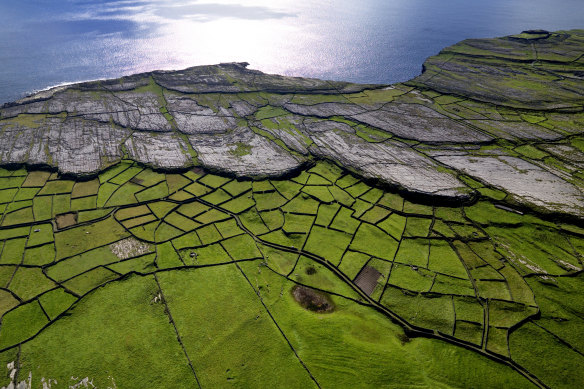
Inishmore, Aran Islands.
Ireland enchants and entertains in generous measures with its engaging cast of characters you’re bound to meet on your journey, some with toe-tapping tunes and ballads, others with quips and anecdotes in accents as silky smooth as the whiskey flowing from the distilleries here.
Whether you’re a first-time or returning traveller, there are countless potential itineraries to consider, all of which include at least some of Ireland’s collection of still compact but now vibrant, cosmopolitan cities.
Independent touring and road-tripping is easy – like Australia, they drive on the left here – while trusted operators offer multi-day adventures, sorting everything from your ground transport and accommodation to (many) dinners and local guides.
Whichever way you go, things tend to work out just grand in Ireland – a sensation enhanced when you’re nursing a pint of Guinness or an Irish coffee as a live band fuels the craic, the Irish word for fun, chat or entertainment, that you’ll hear, and feel, throughout your trip.
On this occasion, I’m embarking on Collette’s 12-day Shades of Ireland tour, which is book-ended by stays in Dublin and Belfast.
Its appeal is that it covers both Ireland (a country in the European Union) and Northern Ireland (part of the UK). Classic tourist spots and hidden treasures await either side of an Irish land border that, despite Brexit, remains invisible and hassle-free to cross.
Days one to three: From flat whites to the black stuff
“It’s been like this for three weeks now. It’s like a gift from God,” says Donal, our typically amiable coach driver, putting on his flat cap and smiling up at the radiant blue sky.
Even in summer, the Irish are pleasantly surprised to see the sun for an extended period. Temperatures are the mid-20s for our tour, and after the mercurial weather of previous trips, I’m relishing seeing Ireland in a sunny glow, especially as the wet spring has apparently left the countryside as lush as ever.
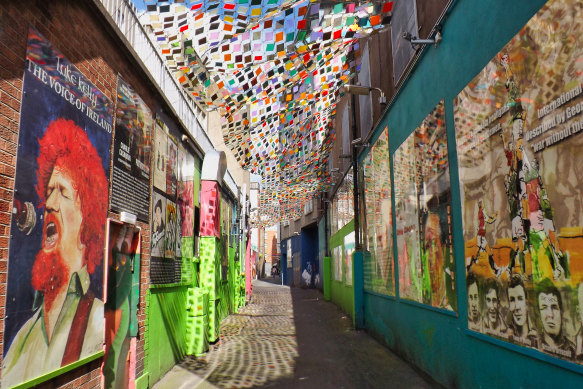
The Icon Walk, Dublin.Credit: Tourism Ireland
But that’s ahead of us. We start in Dublin, with its attractive Georgian streets and squares, Guinness Storehouse – brewing hub of the “black stuff” – and the pub-packed Temple Bar district are busy and rejuvenated (the pandemic and its face masks seem a world away).
We’re staying in the city’s leafy Southside, a stroll from the desirable seaside suburb of Sandymount, a key location in Ulysses, a novel by lauded Dublin writer James Joyce. Across from Sandymount’s beachfront promenade, I see Joyce’s old home, which last year went on the market for €2.15 million ($3.65 million).
As liveable and lovable as Dublin is, we’re happy to swap it for Ireland’s “Ancient East”. After a 90-minute drive south, Kilkenny is upon us, the sight of its medieval castle, lording above the River Nore, eliciting “wows” from my fellow, mostly American, passengers.
Made for historic-fiction yarns, Kilkenny has a compact centre with almost as many handsome stone churches as watering holes.
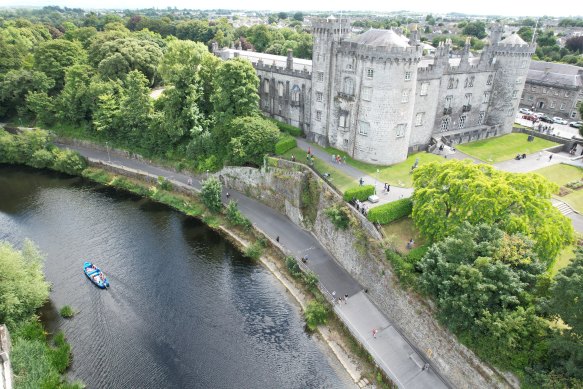
Wow factor: Kilkenny Castle. Credit: Tourism Ireland
Even with my affinity to Ireland, it’s too early for me for a pint at Kyteler’s, a “haunted” inn dating from AD1324, so I sip a pleasing flat white at Low Lane, a Scandinavian-style cafe. A few doors down, a hungover team of young Gaelic footballers are wolfing down full Irish breakfasts.
We press on to Waterford. Touted as Ireland’s oldest city, it was established by early 10th-century Vikings (about 70 years before they properly founded Dublin). The Anglo-Normans of England then invaded in AD1171 and began colonising the island.
Waterford is known for its crystal production and some of our group take a factory tour. But the city’s street art dazzles me more. There are super-sized contemporary murals and a 23-metre sword, hand-crafted from a fallen fir tree, engraved with episodes of Viking heritage.
We stumble across a Normandy-themed festival on Cathedral Square, where visiting stall-holders are proffering complimentary cheeses, ciders and craft beers from their region of northern France, where the Vikings also settled.
At the neighbouring Medieval Museum, we browse precious silk and gold vestments, then enjoy a glass of wine in the 15th-century vault.
Later we’re served beef and Guinness stew at our hotel, the Granville, which was the birthplace of Thomas Francis Meagher, an Irish patriot who raised the Irish tricolour flag for the first time, here in Waterford, in 1848. Meagher’s life story is a screenwriter’s dream.
Imprisoned and sent to Van Diemen’s Land (Tasmania) after rebelling against British rule in Ireland, he escaped, relocating to New York and fighting in the American Civil War. His disappearance – and presumed death – in Montana is still cloaked in mystery.
Days four to six: Of the Blarney Stone and Luke Skywalker
Talking of far-fetched tales, have you heard the one about the Blarney Stone? Embedded in the tower of a semi-ruined fortress outside Cork, it’s said to possess supernatural powers, imparting eloquence (or “the gift of the gab”) to those who kiss it. Briefly locked away during the pandemic, it’s open again and regularly sprayed with disinfectant.
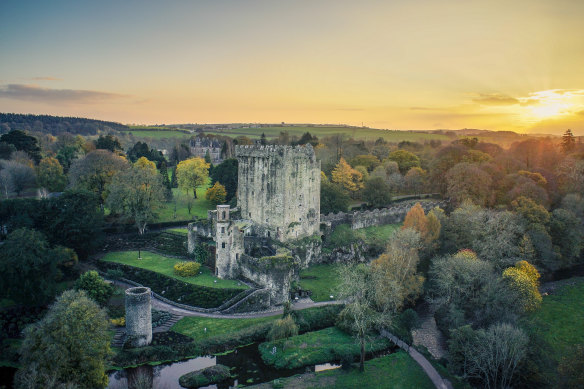
It’s worth skipping kissing the Blarney Stone and exploring the castle and gardens instead.
“This is gonna be like waiting for a ride at Disneyland,” says one of our group, joining the fast-growing queue. I explore the wider 24-hectare Blarney estate instead. Aromatic and idyllic, its arboretums are rich in oaks and pines, the gardens bountiful in fern, bamboo, rhododendron and other vivid petals warmed by the Gulf Stream, an ocean current that keeps Ireland mild relative to its northerly latitude.
I pass caves and rockeries wrapped in fables of druids and witches, and behind the castle battlements is a “poison garden”. It contains the likes of hemlock, nightshade and wolfsbane plus a sign with a skull and a warning not to touch, smell or eat any plant.
Someone who definitely doesn’t need any Blarney-induced eloquence is Peter, our Anglo-Australian tour manager.
His on-board commentary blends history, philosophy and repartee, and he also alerts us to sites we’d otherwise probably miss, such as Iron Age ring forts, places associated with St Patrick, and so-called “famine villages”, which were abandoned in the mid-19th century when the potato crop failed, causing starvation and waves of Irish emigration, including to Australia.
Over-crowded ships also carried Irish across the Atlantic Ocean. Its blue blanket steals our collective gaze on the Wild Atlantic Way, a 2600-kilometre touring route that we follow, on and off, along Ireland’s west coast.
A supremely scenic section is the Ring of Kerry, a 179-kilometre loop flaunting turquoise-toned coves, cattle-spotted pastures and the MacGillycuddy’s Reeks, Ireland’s highest mountain range (1038 metres).
Driver Donal knows these winding roads like the back of his hand (he’s a sheep farmer here in County Kerry when he’s not behind the wheel).
After a pit stop in the quaint seaside village of Waterville where there’s a statue of Charlie Chaplin who used to holiday here, we pull over for a glimpse of Skellig Michael. A rocky silhouette near the horizon, this island was a refuge for medieval monks, before doubling as Luke Skywalker’s hermitage in the Star Wars saga.
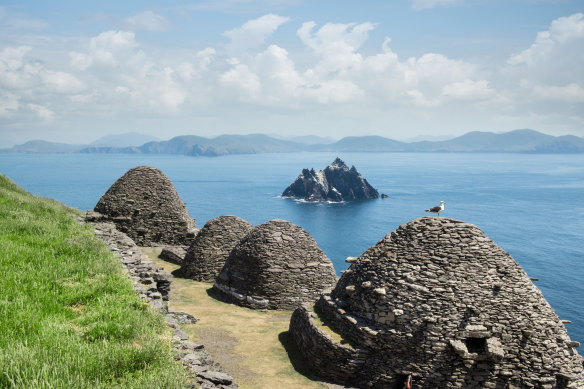
Skellig Michael doubled as Luke Skywalker’s refuge in Star Wars: The Last Jedi.Credit: Tourism Ireland
The next day, in County Clare, we hike a spine-tingling, salty-aired footpath on the Cliffs of Moher, with the Atlantic churning more than 200 metres below.
Seabirds dart by the sheer cliff faces, and boats zip out to the Aran Islands, where scenes were shot for The Banshees Of Inisherin, a 2022 Oscar-nominated tragicomedy starring Colin Farrell and Brendan Gleeson.
There are laughs aplenty later at Knappogue Castle, a restored AD1467 pile hosting medieval banquet shows by performers in flamboyant period costumes.
In a Game of Thrones-like setting, with clannish banners draped by long, candlelit wooden tables, we sip mead and wine, tuck into dishes like chicken in red-wine sauce and watch lighthearted takes on Irish myths, ancient kings and fair maidens.
Harps and fiddles are plucked, lines delivered with knowing grins and there’s even some Michael Flatley-style ceilidh dancing. It’s a good craic, as they say.
Days seven to nine: Back and forth across the border
“I’ve just put the scones in the oven,” says Frances, greeting us at her family farm in County Galway. “We’ll have them with rhubarb, ginger jam and freshly-whipped cream. They’ll be delicious.”
She’s true to her word, serving the still-warm scones with tea in her thatched cottage after farm patriarch Fintan shares the art of shepherding with Bailey, his long-haired border collie. He also introduces us to lambs born just yesterday.
We head on for lunch in Galway, a lively university port city with bohemian hostelries and street buskers, before driving north via Sligo, where the flat-topped peak of Benbulbin reminds me of Cape Town’s Table Mountain.
The bucolic scenery endures as we cross the unmanned border into Northern Ireland. If it wasn’t for the road signs’ different typeface and colours, you wouldn’t immediately realise you were in another country, though other changes – twangs, distances (miles rather than kilometres) currency (pounds not euros) and flags (British as well as Irish) – become apparent later.
Arriving at the Manor House Country Hotel, it (briefly) feels like we’ve been transported to the Mediterranean. The sun blazes over this 19th-century Italianate retreat by Lough Erne, a yacht-speckled lake near Enniskillen town.
European dishes with Irish ingredients are a forte of the hotel’s Belleek Restaurant, where the mushroom risotto, baked hake with saffron and herb sauce, and creme brulee with strawberries and shortbread all hit the spot.
The next few days see us hopping back and forth across the border to Ireland’s County Donegal, where we meet Dennis, a fifth-generation weaver, who looks and sounds a bit like my late grandad, who was born not far from here, before Ireland was partitioned in 1921.
Dennis demonstrates his craft on a hand loom, then we check out his store’s tweed jackets, waistcoats, scarves, flat caps and sweaters.
They’re mostly shaded salt-and-pepper, gorse yellow, heather purple and moss green, colours that characterise Donegal’s boggy landscapes, particularly on the Inishowen peninsula, whose windswept headland, Malin Head, is the Emerald Isle’s northernmost point.
After a gentle clifftop walk, we hit nearby Farren’s Bar, which has been in the same family since 1825.
“The funny thing is, we’re in Ireland here, which people often call ‘the south’, but this is the most northerly pub on the whole island,” says owner Hugh, pouring me a Guinness and recounting the time the crew for Star Wars: The Last Jedi called in while filming at Malin Head. Hugh shows us a signed Stormtrooper boot and points at a photograph on the wall. It’s him with Mark Hamill (Luke Skywalker).
Days 10 to 12: Leaving The Troubles behind
The wooded mountains of County Donegal are visible from the 400-year city walls of Derry, or Londonderry, Northern Ireland’s second-largest city.
“Like New York, our city is so good they named us twice,” jokes guide Pete, leading us along the 1.5 kilometre-long stone fortifications. “Call us what you want actually. We’re not interested in semantics. We’re interested in peace. And it’s been phenomenal.”
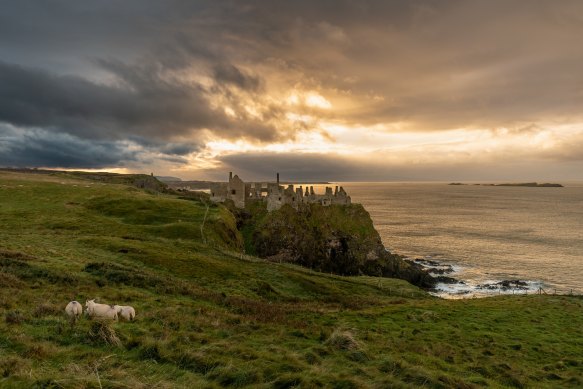
The cinematic Dunluce Castle.
Raised here during “The Troubles”, a near three-decade period scarred by sectarian violence, Pete waxes lyrical about the turnaround since the 1998 Good Friday Agreement, a peace deal that eased tensions between the province’s Catholic or Nationalist communities (who largely see themselves as Irish and call this city Derry), and the Protestants, or Loyalists, who mostly identify as British and call it Londonderry.
Walking the walls, we see a mixed-aged crowd mingling on the terraces of bars and cafes below, and by one beer garden, there’s a mural of Derry Girls.
Pete says this 1990-set TV comedy-drama has really stoked tourist interest here, with props from the show filling a new exhibition at the Tower Museum, a landmark by the city gates.
Even under muggy overcast skies (a thunderstorm, we sense, is coming), the coastal drive to Belfast is a stunner. White-sand beaches lapped by bluey-green waters, luxuriant links golf courses and the ghostly shell of Dunluce Castle all captivate.
But stealing the show is Giant’s Causeway, where we clamber on this surreal tapestry of 40,000-plus basalt columns.
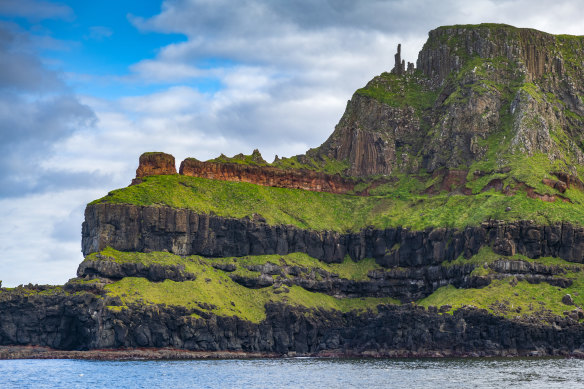
Scene stealer: the Giant’s Causeway.
Belfast is an absorbing place to end our trip. While some neighbourhoods remain segregated – a coach tour reveals the partisan murals of Catholic and Protestant-dominated streets in west Belfast – Northern Ireland’s capital feels tourist-friendly.
Its Victorian core has progressive bars and coffee haunts, live-music venues and Michelin-starred restaurants where “The Troubles” seem a distant memory.
We stay at the Europa, which was targeted so often by paramilitaries between the 1970s and 90s, it was dubbed “the world″s most bombed hotel”. Bill Clinton, Bono and Julia Roberts are notable former guests and it’s looking rather slick after a $20 million refurbishment.
After visiting Titanic Belfast, an excellent, recently-expanded attraction chronicling the legacy of the doomed vessel at the shipyard where it was built, I bid farewell to my fellow travellers and enjoy one last city amble.
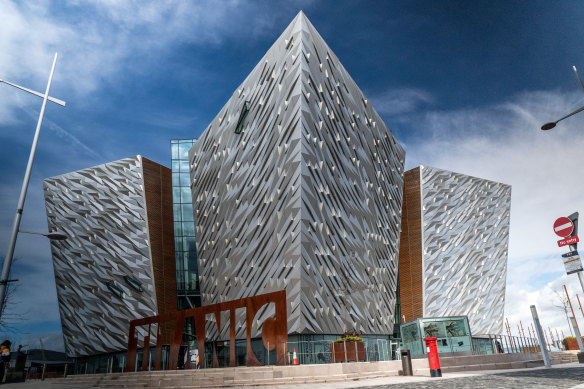
Titanic Belfast.
Suddenly I hear a voice. “Steve McKenna, what’s the craic?” I turn around to see a familiar face. It’s Des, an old Irish mate I’d met travelling in South America over a decade ago. We’d lost touch, but bumping into him again – he’d just left the office to grab some lunch – is a lovely surprise.
He shares his number and says to call if I’m over this way again. There’s certainly a fair chance of that. The Emerald Isle has worked its magic on me once more.
The writer visited Ireland as a guest of Collette.
THE DETAILS
Tour
Collette’s 12-day Shades of Ireland including Northern Ireland tour is priced from $3.999 per person, departing between March and November. Some experiences, including the Knappogue banquet and Guinness Storehouse, incur an additional fee. See gocollette.com
Fly
Fly to Dublin with Emirates or Qatar (via Dubai or Doha, respectively) from Sydney and Melbourne. If you combine a trip to Ireland with Britain, there are regular flights to Dublin and Belfast from London, Birmingham, Manchester and other cities. See emirates.com
More
ireland.com
Five more things to see and do
Killarney National Park
Take a serene lake cruise in this picturesque, mountainous pocket of County Kerry, calling in at Innisfallen, a tiny island home to wild deer and a ruined 7th abbey. See discoverkerry.com
Whiskey distilleries
Joining stalwarts like Bushmills and Jameson, fledgling distilleries are sprouting, especially in Dublin’s Liberties district, while south of Belfast, sample whiskey and delicious modern Irish cuisine at the sleek new Hinch Distillery. See hinchdistillery.com
Irish Wake Museum
The Irish are renowned for giving their late loved ones a “good send off” and this new Waterford museum charts the customs, traditions and superstitions from early Christian times to the present day. See waterfordtreasures.com
Game of Thrones Studio Tour
A treat for “Thronies”, the global HBO hit series former filming studios south of Belfast are packed with original sets, props, outfits and interactive exhibits. See gameofthronesstudiotour.com
Soundtracks for the road
The Emerald Isle has spawned a medley of musical talent, including U2, Van Morrison, the Cranberries, the Corrs, the Dubliners, the Pogues, Enya, the Undertones, Thin Lizzy and so many more. Create a playlist for your grand Irish adventure. See ireland.com
Sign up for the Traveller Deals newsletter
Get exclusive travel deals delivered straight to your inbox. Sign up now.